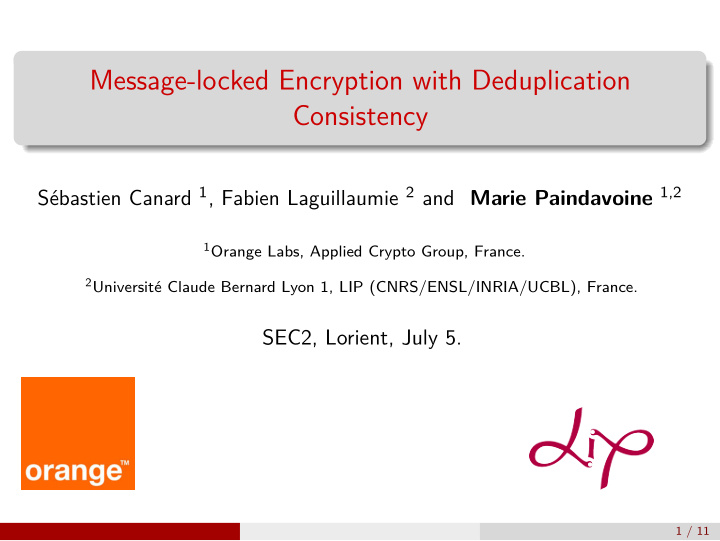



Message-locked Encryption with Deduplication Consistency Sébastien Canard 1 , Fabien Laguillaumie 2 and Marie Paindavoine 1,2 1 Orange Labs, Applied Crypto Group, France. 2 Université Claude Bernard Lyon 1, LIP (CNRS/ENSL/INRIA/UCBL), France. SEC2, Lorient, July 5. 1 / 11
Deduplication : Saving Space Storage. 2 / 11
The Secure Deduplication Problem What if the cloud server is distrusted? Alice and Bob could use encryption How can the server perform deduplication? Two main challenges The server should be able to check that two ciphertexts encrypt the same message. Bob should be able to decrypt Alice’s ciphertexts. 3 / 11
The Convergent Encryption Solution [DABS02] H is a deterministic hash function. Enc is a deterministic encryption scheme. Two encryptions of M (even by different persons) yield the same C . Server can test if two ciphertexts are equal. 4 / 11
The MLE Model [BKR13,ABMRS13] Formalization and generalization of convergent encryption. Definition of a formal security model. Give a solution in a non-deterministic setting. It suffices to have a tag and an equality test procedure. 5 / 11
Main Security Requirements Privacy for unpredictable data only. Tag-consistency. ◮ T 1 = T 2 implies that underlying messages are equal. Privacy holds when messages are correlated? Privacy holds when messages are dependent from public parameters? Construction fulfilling all of those requirements are (very) inefficient [ABMRS13,BK15] 6 / 11
Deduplication Consistency? New security requirement. If the messages are equal, then the equality test on ciphertexts returns 1. Not achieved in convergent encryption and (most of) MLE. Adds verifiability to MLE. Useful for the right-to-be-forgotten. 7 / 11
Our Scheme KeyGen: algebraic hash function. M is divided into (small) blocks M i Use of a bilinear map e for the equality testing. � a M i k M = k M 1 u 1 i With 2 tags : ( t u 1 1 , t ) . 2 Enc ElGamal encryptions of each k M 2 u 2 and ( t u 2 1 , t ) . 2 M i Test if k M 2 u 2 k M 1 u 1 e ( t u 1 ) = e ( t u 2 1 , t 1 , t ) . T 1, i = g r i i , T 2, i = h M i g k M r i 2 2 . i 1 , t k M u Tags : ( t u ) . 2 8 / 11
Ensuring Deduplication Consistency KeyGen: algebraic hash function. M is divided into (small) blocks Goal: proving all those values M i were consistently computed. We use zero-knowledge proofs. � a M i k M = The user can prove every value is i consistently derived from the Enc ElGamal encryptions of each secret message M without M i revealing it. Algebraic hash function ensures T 1, i = g r i i , T 2, i = h M i g k M r i . that the efficiency is linear in the i size of the message. 1 , t k M u Tags : ( t u ) . 2 9 / 11
Conclusion and Perspectives A probabilistic scheme with new security features. (Sort of) efficient. Can we have all security features and still be efficient? "Fuzzy" deduplication? 10 / 11
Thank you! Any question? 11 / 11
Recommend
More recommend